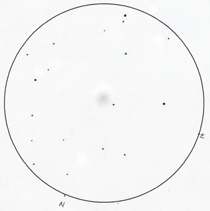 This is among the more challenging Palomar globular star clusters. OK, none of the them--with the possible exception of Palomar 8--is exactly a showpiece, but Palomar 4 gives real meaning to the phrase, "faint fuzzy." My drawing captures a 199X view in the 46 cm (18-inch) Obsession. The field is defined by the L-shaped collection of stars in the southeast quadrant. 9.8 magnitude SAO 81851 stands just inside the eastern edge of the field. PPM 101191 is the 10.0 magnitude ember near the southern boundary. A 12th magnitude star lies just north of it. And the feeble point of light at the center of my sketch shines at 14th magnitude. Palomar 4 is seen as a ghostly haze just to the southwest of this star. Palomar 4 teases the eye, a 1'.2 diameter gauzy patch of light that is only seen with averted vision, but always in the correct location. At 18th magnitude, even the brightest residents of Palomar 4 lie beyond the reach of my scope. More typically, this cluster's stars shine at 20th magnitude or fainter. Discovered in 1949 by Edwin Hubble, Palomar 4 was initially thought to be a nearby dwarf galaxy and was given the moniker, Ursa Major Dwarf. However, its status as a distant halo globular of the Milky Way has since been well-established.
This is among the more challenging Palomar globular star clusters. OK, none of the them--with the possible exception of Palomar 8--is exactly a showpiece, but Palomar 4 gives real meaning to the phrase, "faint fuzzy." My drawing captures a 199X view in the 46 cm (18-inch) Obsession. The field is defined by the L-shaped collection of stars in the southeast quadrant. 9.8 magnitude SAO 81851 stands just inside the eastern edge of the field. PPM 101191 is the 10.0 magnitude ember near the southern boundary. A 12th magnitude star lies just north of it. And the feeble point of light at the center of my sketch shines at 14th magnitude. Palomar 4 is seen as a ghostly haze just to the southwest of this star. Palomar 4 teases the eye, a 1'.2 diameter gauzy patch of light that is only seen with averted vision, but always in the correct location. At 18th magnitude, even the brightest residents of Palomar 4 lie beyond the reach of my scope. More typically, this cluster's stars shine at 20th magnitude or fainter. Discovered in 1949 by Edwin Hubble, Palomar 4 was initially thought to be a nearby dwarf galaxy and was given the moniker, Ursa Major Dwarf. However, its status as a distant halo globular of the Milky Way has since been well-established. |
![]()
![]()
